Critical Appraisal of Sampling Strategies in Nursing Research Articles
VerifiedAdded on 2022/08/18
|14
|4266
|21
Essay
AI Summary
This essay critically analyzes the sample selection methods employed in two nursing research articles: Wang et al. (2019) on social media usage and online professionalism among registered nurses, and Lewis et al. (2019) on midwives' perceptions of mobile phone use. The essay focuses on the element of sample selection, evaluating the reliability, validity, and credibility of each study's approach. Wang et al. (2019) used convenience sampling with inclusion criteria, while Lewis et al. (2019) provided limited information about the sampling technique. The analysis considers potential biases, such as selection bias and non-responsive bias, and discusses the impact of sample size and participant recruitment on the overall generalizability of the research findings. The essay highlights the importance of appropriate sampling strategies in nursing research to ensure the quality of care and evidence-based practice. Both studies' limitations and strengths regarding sampling are discussed, emphasizing the need for clear and detailed descriptions of sampling procedures to enhance research validity and reliability, and the ethical considerations of informed consent are also considered.
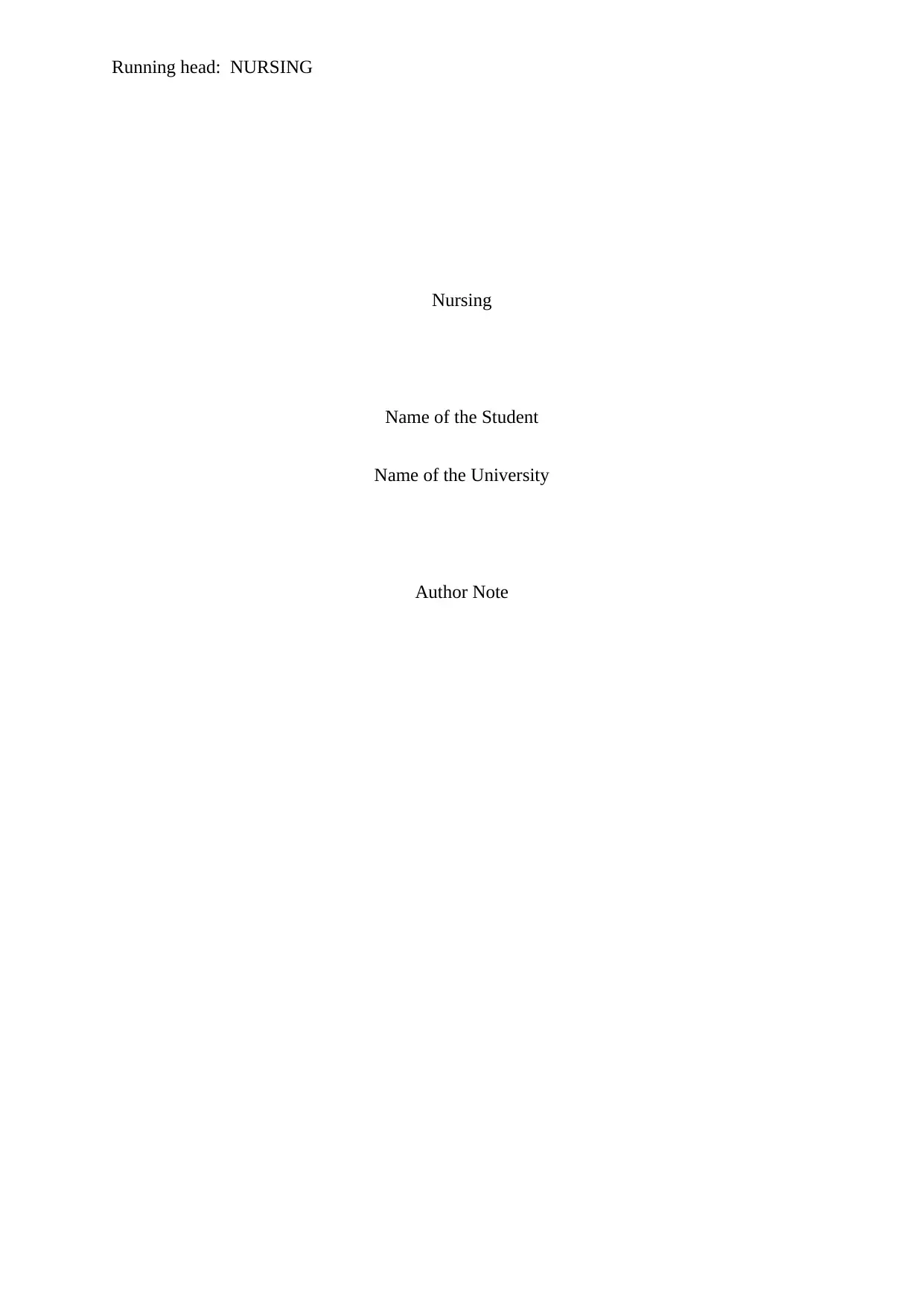
Running head: NURSING
Nursing
Name of the Student
Name of the University
Author Note
Nursing
Name of the Student
Name of the University
Author Note
Paraphrase This Document
Need a fresh take? Get an instant paraphrase of this document with our AI Paraphraser
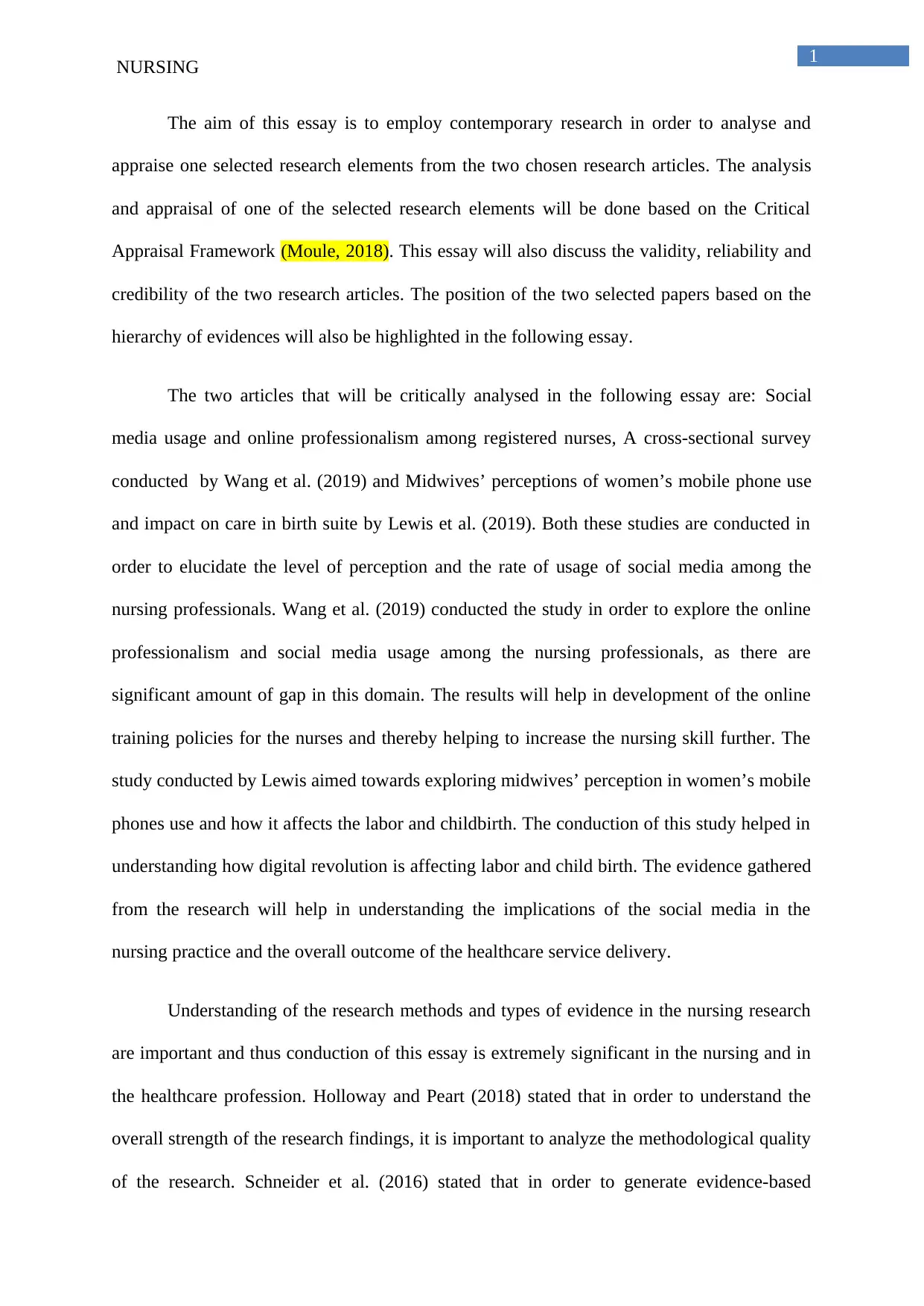
1
NURSING
The aim of this essay is to employ contemporary research in order to analyse and
appraise one selected research elements from the two chosen research articles. The analysis
and appraisal of one of the selected research elements will be done based on the Critical
Appraisal Framework (Moule, 2018). This essay will also discuss the validity, reliability and
credibility of the two research articles. The position of the two selected papers based on the
hierarchy of evidences will also be highlighted in the following essay.
The two articles that will be critically analysed in the following essay are: Social
media usage and online professionalism among registered nurses, A cross-sectional survey
conducted by Wang et al. (2019) and Midwives’ perceptions of women’s mobile phone use
and impact on care in birth suite by Lewis et al. (2019). Both these studies are conducted in
order to elucidate the level of perception and the rate of usage of social media among the
nursing professionals. Wang et al. (2019) conducted the study in order to explore the online
professionalism and social media usage among the nursing professionals, as there are
significant amount of gap in this domain. The results will help in development of the online
training policies for the nurses and thereby helping to increase the nursing skill further. The
study conducted by Lewis aimed towards exploring midwives’ perception in women’s mobile
phones use and how it affects the labor and childbirth. The conduction of this study helped in
understanding how digital revolution is affecting labor and child birth. The evidence gathered
from the research will help in understanding the implications of the social media in the
nursing practice and the overall outcome of the healthcare service delivery.
Understanding of the research methods and types of evidence in the nursing research
are important and thus conduction of this essay is extremely significant in the nursing and in
the healthcare profession. Holloway and Peart (2018) stated that in order to understand the
overall strength of the research findings, it is important to analyze the methodological quality
of the research. Schneider et al. (2016) stated that in order to generate evidence-based
NURSING
The aim of this essay is to employ contemporary research in order to analyse and
appraise one selected research elements from the two chosen research articles. The analysis
and appraisal of one of the selected research elements will be done based on the Critical
Appraisal Framework (Moule, 2018). This essay will also discuss the validity, reliability and
credibility of the two research articles. The position of the two selected papers based on the
hierarchy of evidences will also be highlighted in the following essay.
The two articles that will be critically analysed in the following essay are: Social
media usage and online professionalism among registered nurses, A cross-sectional survey
conducted by Wang et al. (2019) and Midwives’ perceptions of women’s mobile phone use
and impact on care in birth suite by Lewis et al. (2019). Both these studies are conducted in
order to elucidate the level of perception and the rate of usage of social media among the
nursing professionals. Wang et al. (2019) conducted the study in order to explore the online
professionalism and social media usage among the nursing professionals, as there are
significant amount of gap in this domain. The results will help in development of the online
training policies for the nurses and thereby helping to increase the nursing skill further. The
study conducted by Lewis aimed towards exploring midwives’ perception in women’s mobile
phones use and how it affects the labor and childbirth. The conduction of this study helped in
understanding how digital revolution is affecting labor and child birth. The evidence gathered
from the research will help in understanding the implications of the social media in the
nursing practice and the overall outcome of the healthcare service delivery.
Understanding of the research methods and types of evidence in the nursing research
are important and thus conduction of this essay is extremely significant in the nursing and in
the healthcare profession. Holloway and Peart (2018) stated that in order to understand the
overall strength of the research findings, it is important to analyze the methodological quality
of the research. Schneider et al. (2016) stated that in order to generate evidence-based
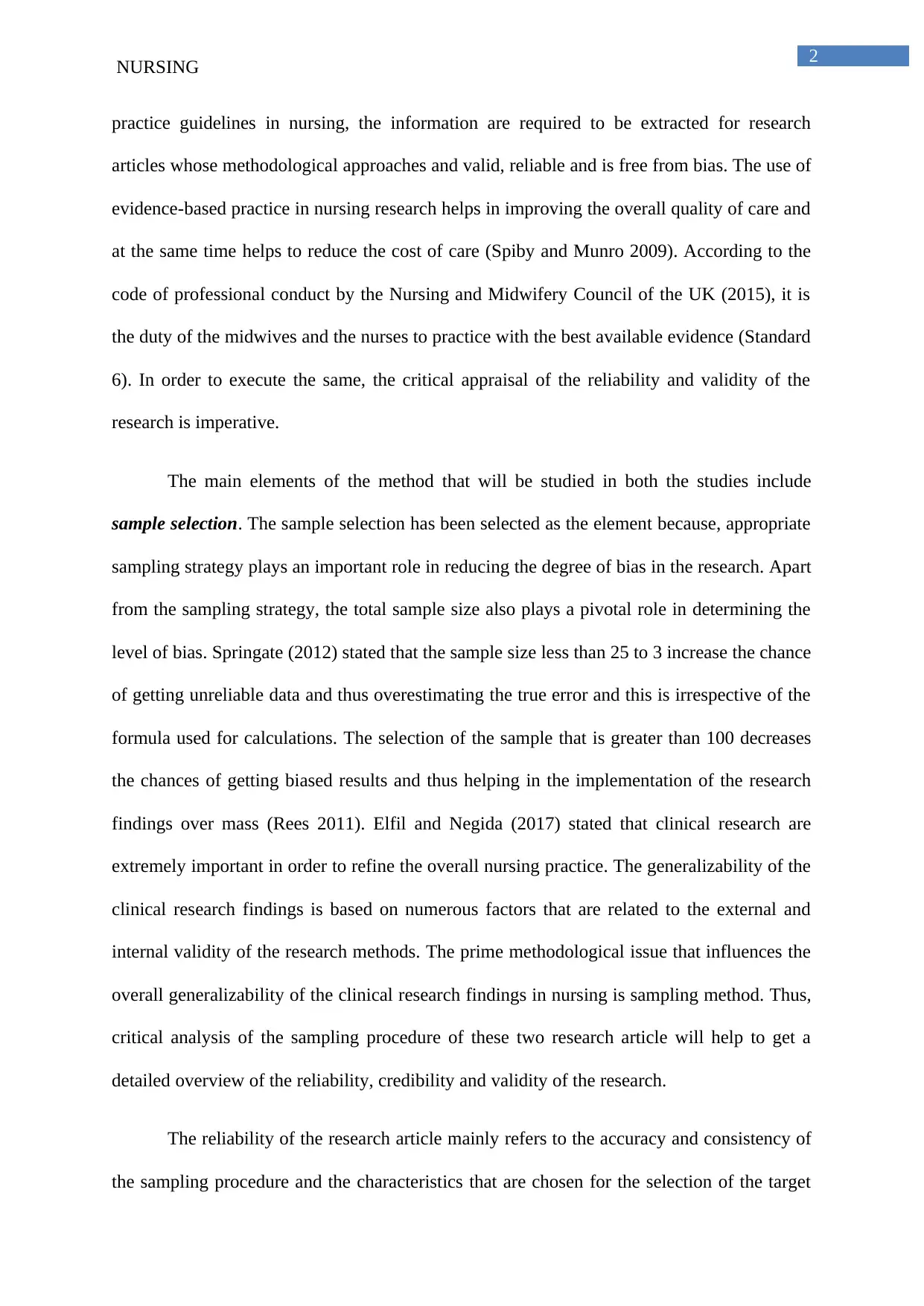
2
NURSING
practice guidelines in nursing, the information are required to be extracted for research
articles whose methodological approaches and valid, reliable and is free from bias. The use of
evidence-based practice in nursing research helps in improving the overall quality of care and
at the same time helps to reduce the cost of care (Spiby and Munro 2009). According to the
code of professional conduct by the Nursing and Midwifery Council of the UK (2015), it is
the duty of the midwives and the nurses to practice with the best available evidence (Standard
6). In order to execute the same, the critical appraisal of the reliability and validity of the
research is imperative.
The main elements of the method that will be studied in both the studies include
sample selection. The sample selection has been selected as the element because, appropriate
sampling strategy plays an important role in reducing the degree of bias in the research. Apart
from the sampling strategy, the total sample size also plays a pivotal role in determining the
level of bias. Springate (2012) stated that the sample size less than 25 to 3 increase the chance
of getting unreliable data and thus overestimating the true error and this is irrespective of the
formula used for calculations. The selection of the sample that is greater than 100 decreases
the chances of getting biased results and thus helping in the implementation of the research
findings over mass (Rees 2011). Elfil and Negida (2017) stated that clinical research are
extremely important in order to refine the overall nursing practice. The generalizability of the
clinical research findings is based on numerous factors that are related to the external and
internal validity of the research methods. The prime methodological issue that influences the
overall generalizability of the clinical research findings in nursing is sampling method. Thus,
critical analysis of the sampling procedure of these two research article will help to get a
detailed overview of the reliability, credibility and validity of the research.
The reliability of the research article mainly refers to the accuracy and consistency of
the sampling procedure and the characteristics that are chosen for the selection of the target
NURSING
practice guidelines in nursing, the information are required to be extracted for research
articles whose methodological approaches and valid, reliable and is free from bias. The use of
evidence-based practice in nursing research helps in improving the overall quality of care and
at the same time helps to reduce the cost of care (Spiby and Munro 2009). According to the
code of professional conduct by the Nursing and Midwifery Council of the UK (2015), it is
the duty of the midwives and the nurses to practice with the best available evidence (Standard
6). In order to execute the same, the critical appraisal of the reliability and validity of the
research is imperative.
The main elements of the method that will be studied in both the studies include
sample selection. The sample selection has been selected as the element because, appropriate
sampling strategy plays an important role in reducing the degree of bias in the research. Apart
from the sampling strategy, the total sample size also plays a pivotal role in determining the
level of bias. Springate (2012) stated that the sample size less than 25 to 3 increase the chance
of getting unreliable data and thus overestimating the true error and this is irrespective of the
formula used for calculations. The selection of the sample that is greater than 100 decreases
the chances of getting biased results and thus helping in the implementation of the research
findings over mass (Rees 2011). Elfil and Negida (2017) stated that clinical research are
extremely important in order to refine the overall nursing practice. The generalizability of the
clinical research findings is based on numerous factors that are related to the external and
internal validity of the research methods. The prime methodological issue that influences the
overall generalizability of the clinical research findings in nursing is sampling method. Thus,
critical analysis of the sampling procedure of these two research article will help to get a
detailed overview of the reliability, credibility and validity of the research.
The reliability of the research article mainly refers to the accuracy and consistency of
the sampling procedure and the characteristics that are chosen for the selection of the target
⊘ This is a preview!⊘
Do you want full access?
Subscribe today to unlock all pages.

Trusted by 1+ million students worldwide
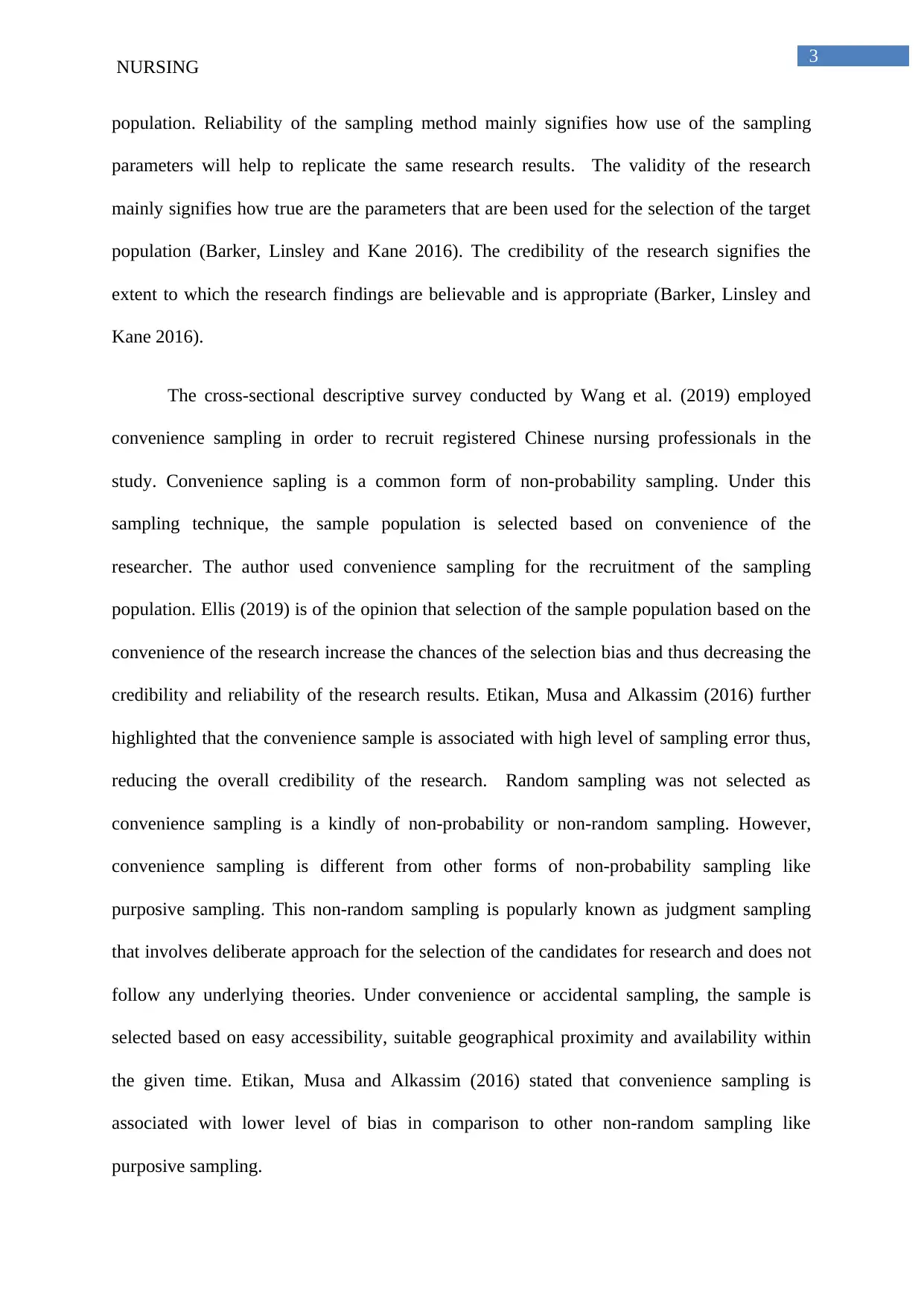
3
NURSING
population. Reliability of the sampling method mainly signifies how use of the sampling
parameters will help to replicate the same research results. The validity of the research
mainly signifies how true are the parameters that are been used for the selection of the target
population (Barker, Linsley and Kane 2016). The credibility of the research signifies the
extent to which the research findings are believable and is appropriate (Barker, Linsley and
Kane 2016).
The cross-sectional descriptive survey conducted by Wang et al. (2019) employed
convenience sampling in order to recruit registered Chinese nursing professionals in the
study. Convenience sapling is a common form of non-probability sampling. Under this
sampling technique, the sample population is selected based on convenience of the
researcher. The author used convenience sampling for the recruitment of the sampling
population. Ellis (2019) is of the opinion that selection of the sample population based on the
convenience of the research increase the chances of the selection bias and thus decreasing the
credibility and reliability of the research results. Etikan, Musa and Alkassim (2016) further
highlighted that the convenience sample is associated with high level of sampling error thus,
reducing the overall credibility of the research. Random sampling was not selected as
convenience sampling is a kindly of non-probability or non-random sampling. However,
convenience sampling is different from other forms of non-probability sampling like
purposive sampling. This non-random sampling is popularly known as judgment sampling
that involves deliberate approach for the selection of the candidates for research and does not
follow any underlying theories. Under convenience or accidental sampling, the sample is
selected based on easy accessibility, suitable geographical proximity and availability within
the given time. Etikan, Musa and Alkassim (2016) stated that convenience sampling is
associated with lower level of bias in comparison to other non-random sampling like
purposive sampling.
NURSING
population. Reliability of the sampling method mainly signifies how use of the sampling
parameters will help to replicate the same research results. The validity of the research
mainly signifies how true are the parameters that are been used for the selection of the target
population (Barker, Linsley and Kane 2016). The credibility of the research signifies the
extent to which the research findings are believable and is appropriate (Barker, Linsley and
Kane 2016).
The cross-sectional descriptive survey conducted by Wang et al. (2019) employed
convenience sampling in order to recruit registered Chinese nursing professionals in the
study. Convenience sapling is a common form of non-probability sampling. Under this
sampling technique, the sample population is selected based on convenience of the
researcher. The author used convenience sampling for the recruitment of the sampling
population. Ellis (2019) is of the opinion that selection of the sample population based on the
convenience of the research increase the chances of the selection bias and thus decreasing the
credibility and reliability of the research results. Etikan, Musa and Alkassim (2016) further
highlighted that the convenience sample is associated with high level of sampling error thus,
reducing the overall credibility of the research. Random sampling was not selected as
convenience sampling is a kindly of non-probability or non-random sampling. However,
convenience sampling is different from other forms of non-probability sampling like
purposive sampling. This non-random sampling is popularly known as judgment sampling
that involves deliberate approach for the selection of the candidates for research and does not
follow any underlying theories. Under convenience or accidental sampling, the sample is
selected based on easy accessibility, suitable geographical proximity and availability within
the given time. Etikan, Musa and Alkassim (2016) stated that convenience sampling is
associated with lower level of bias in comparison to other non-random sampling like
purposive sampling.
Paraphrase This Document
Need a fresh take? Get an instant paraphrase of this document with our AI Paraphraser
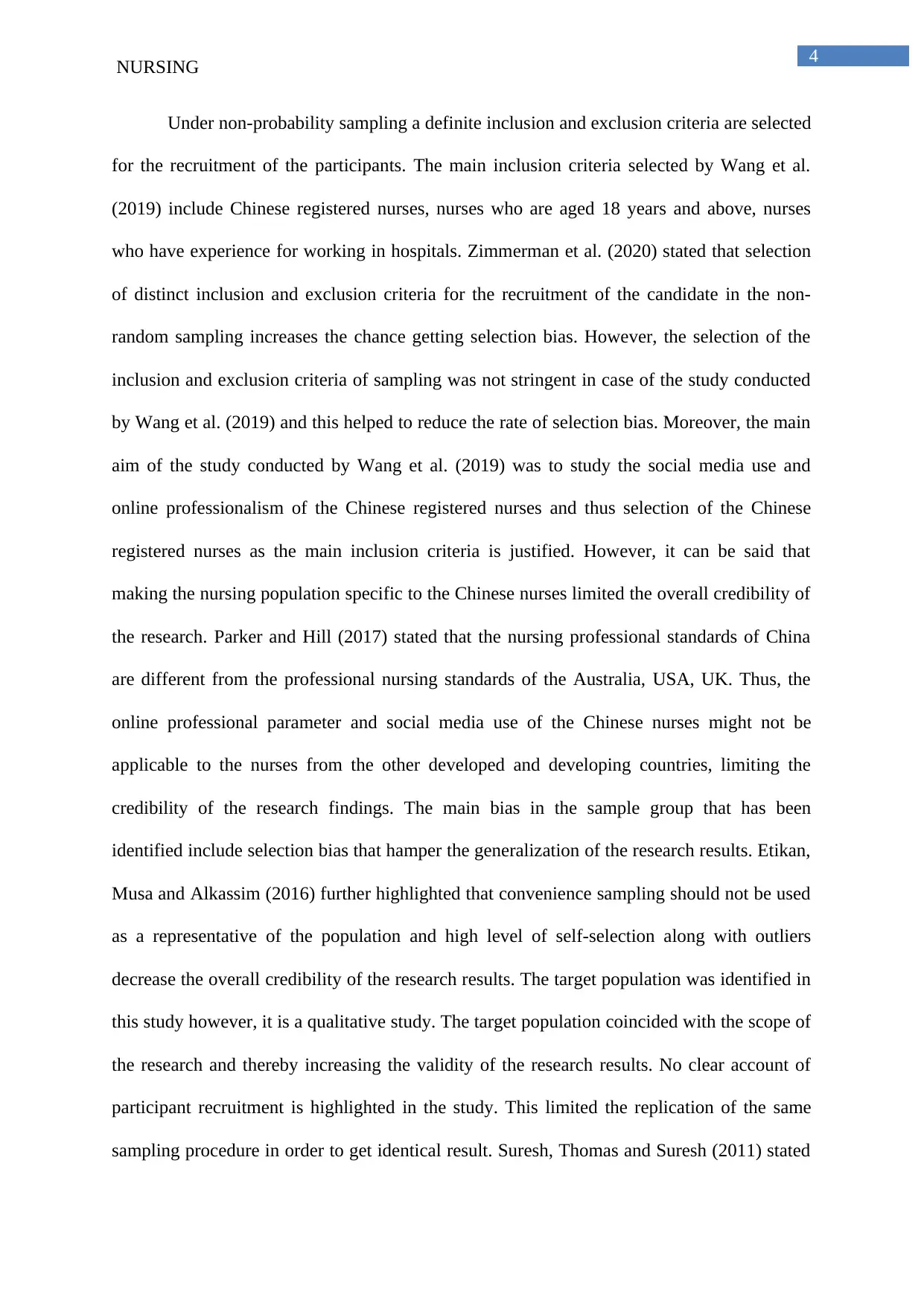
4
NURSING
Under non-probability sampling a definite inclusion and exclusion criteria are selected
for the recruitment of the participants. The main inclusion criteria selected by Wang et al.
(2019) include Chinese registered nurses, nurses who are aged 18 years and above, nurses
who have experience for working in hospitals. Zimmerman et al. (2020) stated that selection
of distinct inclusion and exclusion criteria for the recruitment of the candidate in the non-
random sampling increases the chance getting selection bias. However, the selection of the
inclusion and exclusion criteria of sampling was not stringent in case of the study conducted
by Wang et al. (2019) and this helped to reduce the rate of selection bias. Moreover, the main
aim of the study conducted by Wang et al. (2019) was to study the social media use and
online professionalism of the Chinese registered nurses and thus selection of the Chinese
registered nurses as the main inclusion criteria is justified. However, it can be said that
making the nursing population specific to the Chinese nurses limited the overall credibility of
the research. Parker and Hill (2017) stated that the nursing professional standards of China
are different from the professional nursing standards of the Australia, USA, UK. Thus, the
online professional parameter and social media use of the Chinese nurses might not be
applicable to the nurses from the other developed and developing countries, limiting the
credibility of the research findings. The main bias in the sample group that has been
identified include selection bias that hamper the generalization of the research results. Etikan,
Musa and Alkassim (2016) further highlighted that convenience sampling should not be used
as a representative of the population and high level of self-selection along with outliers
decrease the overall credibility of the research results. The target population was identified in
this study however, it is a qualitative study. The target population coincided with the scope of
the research and thereby increasing the validity of the research results. No clear account of
participant recruitment is highlighted in the study. This limited the replication of the same
sampling procedure in order to get identical result. Suresh, Thomas and Suresh (2011) stated
NURSING
Under non-probability sampling a definite inclusion and exclusion criteria are selected
for the recruitment of the participants. The main inclusion criteria selected by Wang et al.
(2019) include Chinese registered nurses, nurses who are aged 18 years and above, nurses
who have experience for working in hospitals. Zimmerman et al. (2020) stated that selection
of distinct inclusion and exclusion criteria for the recruitment of the candidate in the non-
random sampling increases the chance getting selection bias. However, the selection of the
inclusion and exclusion criteria of sampling was not stringent in case of the study conducted
by Wang et al. (2019) and this helped to reduce the rate of selection bias. Moreover, the main
aim of the study conducted by Wang et al. (2019) was to study the social media use and
online professionalism of the Chinese registered nurses and thus selection of the Chinese
registered nurses as the main inclusion criteria is justified. However, it can be said that
making the nursing population specific to the Chinese nurses limited the overall credibility of
the research. Parker and Hill (2017) stated that the nursing professional standards of China
are different from the professional nursing standards of the Australia, USA, UK. Thus, the
online professional parameter and social media use of the Chinese nurses might not be
applicable to the nurses from the other developed and developing countries, limiting the
credibility of the research findings. The main bias in the sample group that has been
identified include selection bias that hamper the generalization of the research results. Etikan,
Musa and Alkassim (2016) further highlighted that convenience sampling should not be used
as a representative of the population and high level of self-selection along with outliers
decrease the overall credibility of the research results. The target population was identified in
this study however, it is a qualitative study. The target population coincided with the scope of
the research and thereby increasing the validity of the research results. No clear account of
participant recruitment is highlighted in the study. This limited the replication of the same
sampling procedure in order to get identical result. Suresh, Thomas and Suresh (2011) stated
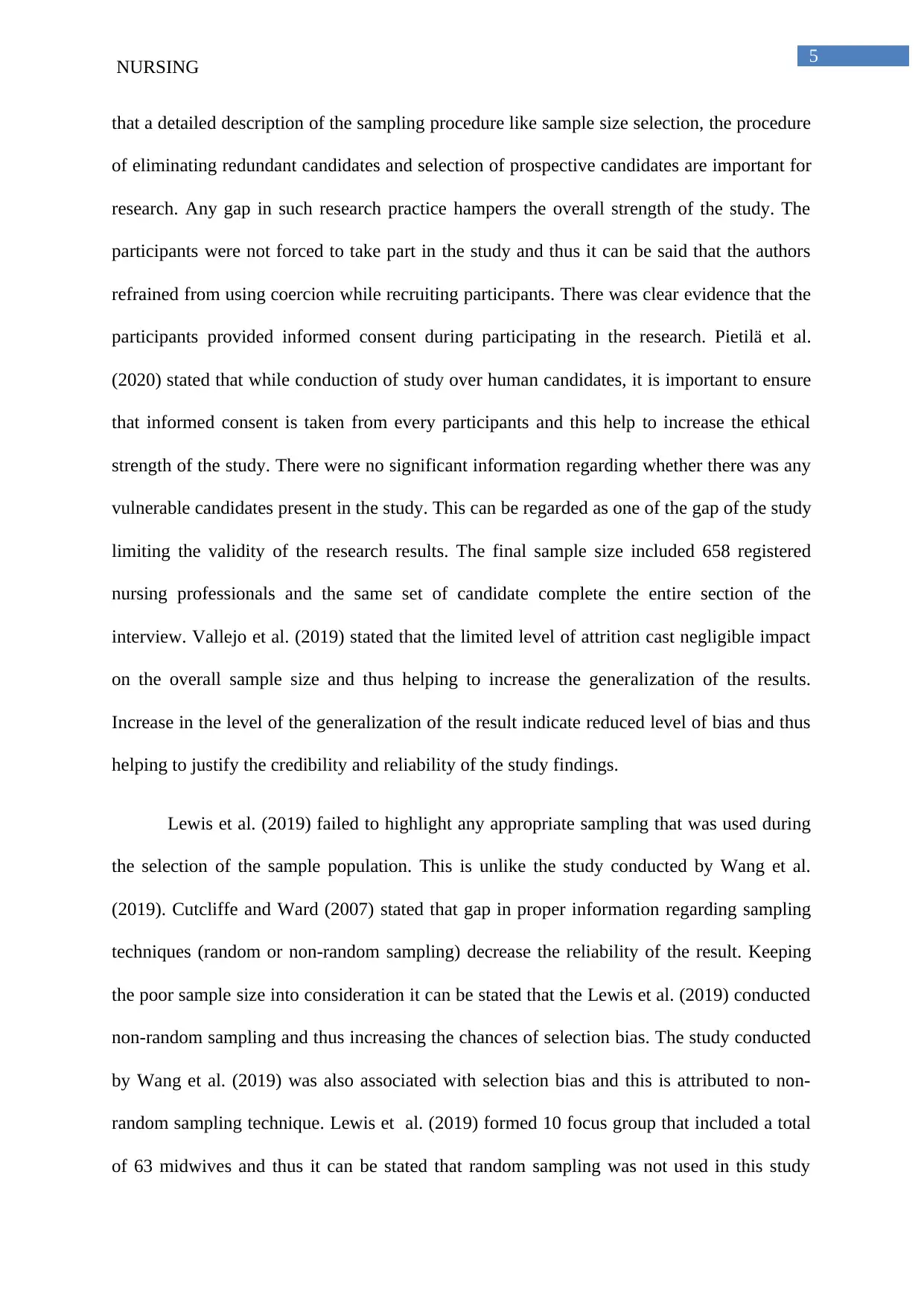
5
NURSING
that a detailed description of the sampling procedure like sample size selection, the procedure
of eliminating redundant candidates and selection of prospective candidates are important for
research. Any gap in such research practice hampers the overall strength of the study. The
participants were not forced to take part in the study and thus it can be said that the authors
refrained from using coercion while recruiting participants. There was clear evidence that the
participants provided informed consent during participating in the research. Pietilä et al.
(2020) stated that while conduction of study over human candidates, it is important to ensure
that informed consent is taken from every participants and this help to increase the ethical
strength of the study. There were no significant information regarding whether there was any
vulnerable candidates present in the study. This can be regarded as one of the gap of the study
limiting the validity of the research results. The final sample size included 658 registered
nursing professionals and the same set of candidate complete the entire section of the
interview. Vallejo et al. (2019) stated that the limited level of attrition cast negligible impact
on the overall sample size and thus helping to increase the generalization of the results.
Increase in the level of the generalization of the result indicate reduced level of bias and thus
helping to justify the credibility and reliability of the study findings.
Lewis et al. (2019) failed to highlight any appropriate sampling that was used during
the selection of the sample population. This is unlike the study conducted by Wang et al.
(2019). Cutcliffe and Ward (2007) stated that gap in proper information regarding sampling
techniques (random or non-random sampling) decrease the reliability of the result. Keeping
the poor sample size into consideration it can be stated that the Lewis et al. (2019) conducted
non-random sampling and thus increasing the chances of selection bias. The study conducted
by Wang et al. (2019) was also associated with selection bias and this is attributed to non-
random sampling technique. Lewis et al. (2019) formed 10 focus group that included a total
of 63 midwives and thus it can be stated that random sampling was not used in this study
NURSING
that a detailed description of the sampling procedure like sample size selection, the procedure
of eliminating redundant candidates and selection of prospective candidates are important for
research. Any gap in such research practice hampers the overall strength of the study. The
participants were not forced to take part in the study and thus it can be said that the authors
refrained from using coercion while recruiting participants. There was clear evidence that the
participants provided informed consent during participating in the research. Pietilä et al.
(2020) stated that while conduction of study over human candidates, it is important to ensure
that informed consent is taken from every participants and this help to increase the ethical
strength of the study. There were no significant information regarding whether there was any
vulnerable candidates present in the study. This can be regarded as one of the gap of the study
limiting the validity of the research results. The final sample size included 658 registered
nursing professionals and the same set of candidate complete the entire section of the
interview. Vallejo et al. (2019) stated that the limited level of attrition cast negligible impact
on the overall sample size and thus helping to increase the generalization of the results.
Increase in the level of the generalization of the result indicate reduced level of bias and thus
helping to justify the credibility and reliability of the study findings.
Lewis et al. (2019) failed to highlight any appropriate sampling that was used during
the selection of the sample population. This is unlike the study conducted by Wang et al.
(2019). Cutcliffe and Ward (2007) stated that gap in proper information regarding sampling
techniques (random or non-random sampling) decrease the reliability of the result. Keeping
the poor sample size into consideration it can be stated that the Lewis et al. (2019) conducted
non-random sampling and thus increasing the chances of selection bias. The study conducted
by Wang et al. (2019) was also associated with selection bias and this is attributed to non-
random sampling technique. Lewis et al. (2019) formed 10 focus group that included a total
of 63 midwives and thus it can be stated that random sampling was not used in this study
⊘ This is a preview!⊘
Do you want full access?
Subscribe today to unlock all pages.

Trusted by 1+ million students worldwide
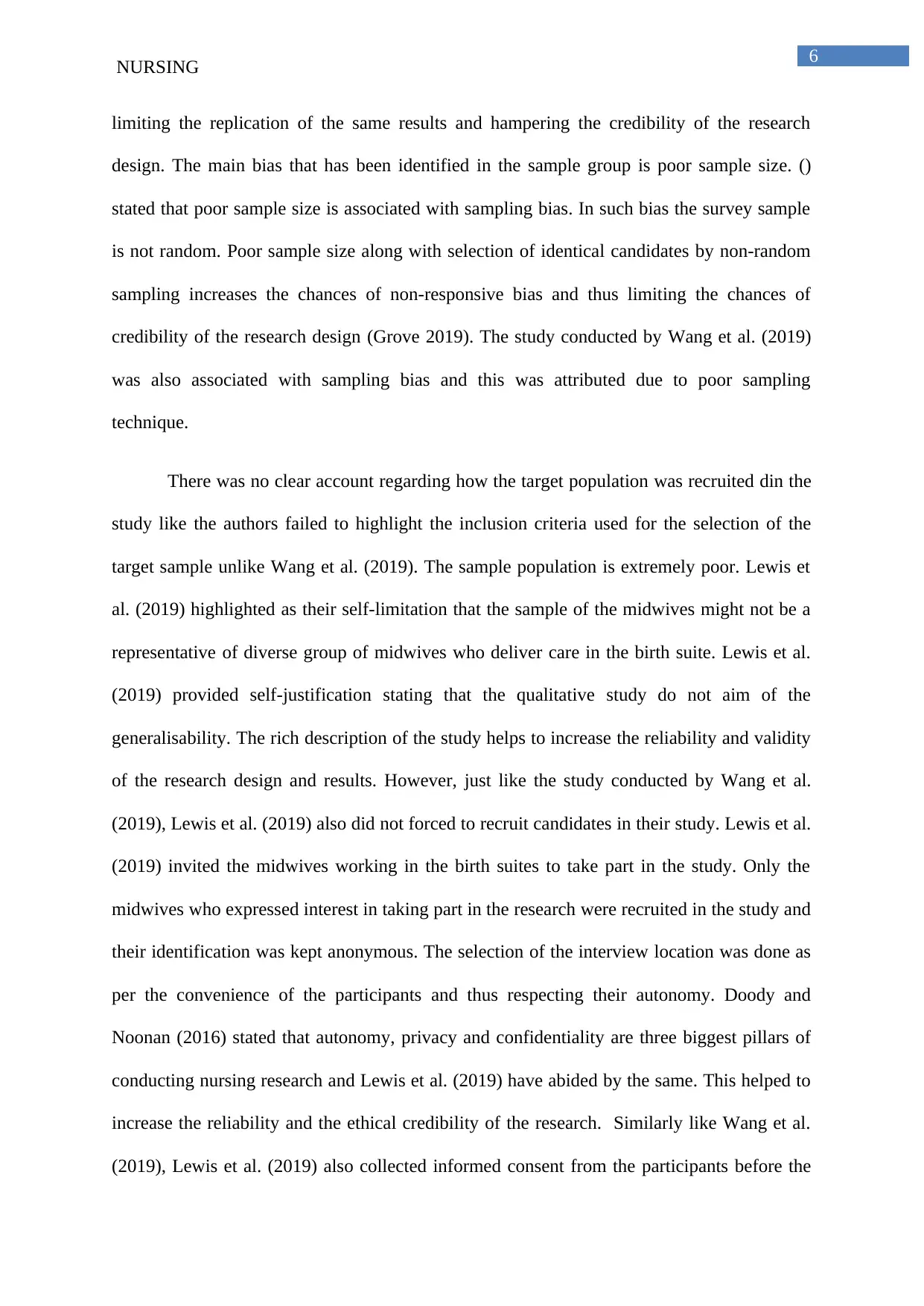
6
NURSING
limiting the replication of the same results and hampering the credibility of the research
design. The main bias that has been identified in the sample group is poor sample size. ()
stated that poor sample size is associated with sampling bias. In such bias the survey sample
is not random. Poor sample size along with selection of identical candidates by non-random
sampling increases the chances of non-responsive bias and thus limiting the chances of
credibility of the research design (Grove 2019). The study conducted by Wang et al. (2019)
was also associated with sampling bias and this was attributed due to poor sampling
technique.
There was no clear account regarding how the target population was recruited din the
study like the authors failed to highlight the inclusion criteria used for the selection of the
target sample unlike Wang et al. (2019). The sample population is extremely poor. Lewis et
al. (2019) highlighted as their self-limitation that the sample of the midwives might not be a
representative of diverse group of midwives who deliver care in the birth suite. Lewis et al.
(2019) provided self-justification stating that the qualitative study do not aim of the
generalisability. The rich description of the study helps to increase the reliability and validity
of the research design and results. However, just like the study conducted by Wang et al.
(2019), Lewis et al. (2019) also did not forced to recruit candidates in their study. Lewis et al.
(2019) invited the midwives working in the birth suites to take part in the study. Only the
midwives who expressed interest in taking part in the research were recruited in the study and
their identification was kept anonymous. The selection of the interview location was done as
per the convenience of the participants and thus respecting their autonomy. Doody and
Noonan (2016) stated that autonomy, privacy and confidentiality are three biggest pillars of
conducting nursing research and Lewis et al. (2019) have abided by the same. This helped to
increase the reliability and the ethical credibility of the research. Similarly like Wang et al.
(2019), Lewis et al. (2019) also collected informed consent from the participants before the
NURSING
limiting the replication of the same results and hampering the credibility of the research
design. The main bias that has been identified in the sample group is poor sample size. ()
stated that poor sample size is associated with sampling bias. In such bias the survey sample
is not random. Poor sample size along with selection of identical candidates by non-random
sampling increases the chances of non-responsive bias and thus limiting the chances of
credibility of the research design (Grove 2019). The study conducted by Wang et al. (2019)
was also associated with sampling bias and this was attributed due to poor sampling
technique.
There was no clear account regarding how the target population was recruited din the
study like the authors failed to highlight the inclusion criteria used for the selection of the
target sample unlike Wang et al. (2019). The sample population is extremely poor. Lewis et
al. (2019) highlighted as their self-limitation that the sample of the midwives might not be a
representative of diverse group of midwives who deliver care in the birth suite. Lewis et al.
(2019) provided self-justification stating that the qualitative study do not aim of the
generalisability. The rich description of the study helps to increase the reliability and validity
of the research design and results. However, just like the study conducted by Wang et al.
(2019), Lewis et al. (2019) also did not forced to recruit candidates in their study. Lewis et al.
(2019) invited the midwives working in the birth suites to take part in the study. Only the
midwives who expressed interest in taking part in the research were recruited in the study and
their identification was kept anonymous. The selection of the interview location was done as
per the convenience of the participants and thus respecting their autonomy. Doody and
Noonan (2016) stated that autonomy, privacy and confidentiality are three biggest pillars of
conducting nursing research and Lewis et al. (2019) have abided by the same. This helped to
increase the reliability and the ethical credibility of the research. Similarly like Wang et al.
(2019), Lewis et al. (2019) also collected informed consent from the participants before the
Paraphrase This Document
Need a fresh take? Get an instant paraphrase of this document with our AI Paraphraser
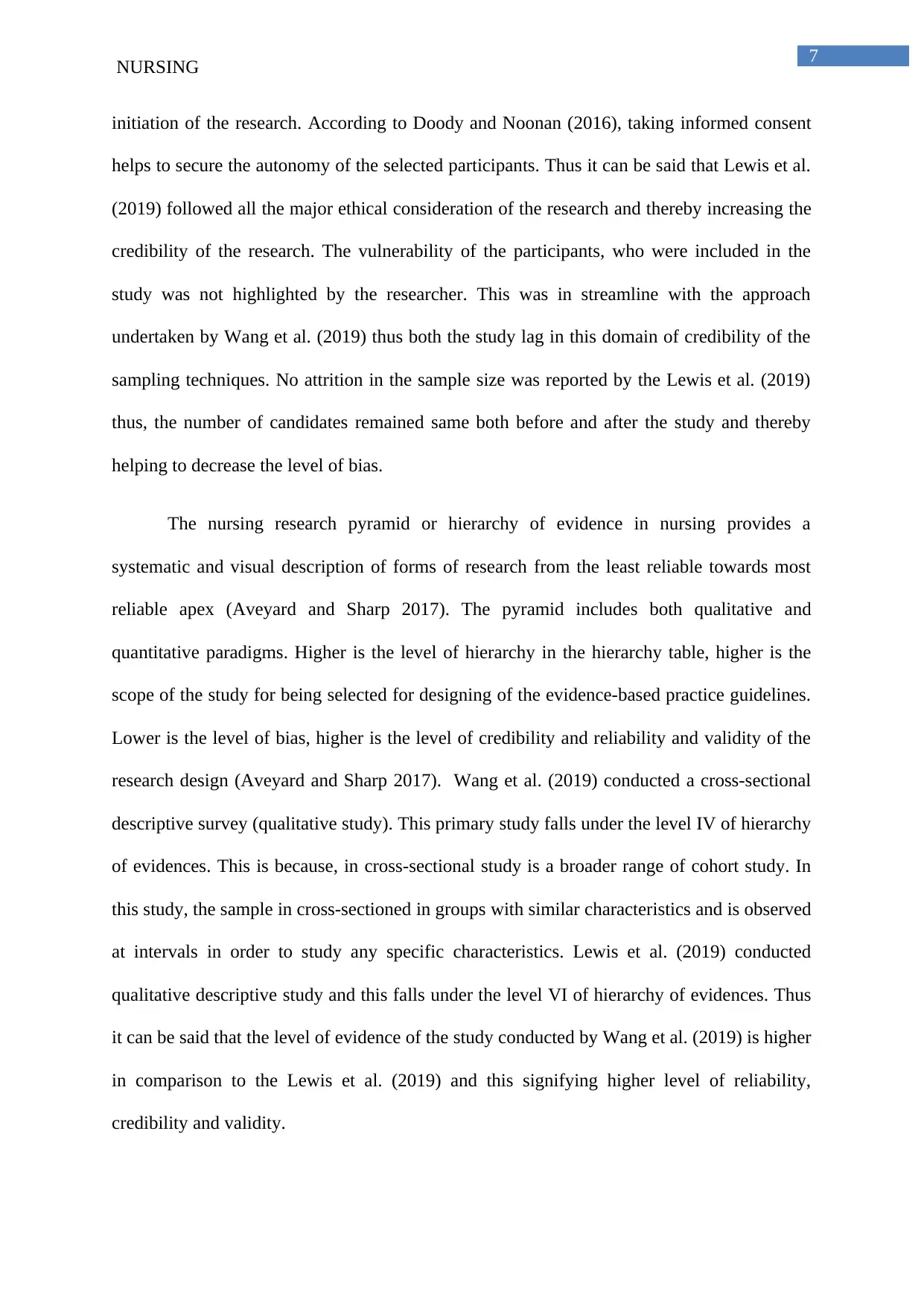
7
NURSING
initiation of the research. According to Doody and Noonan (2016), taking informed consent
helps to secure the autonomy of the selected participants. Thus it can be said that Lewis et al.
(2019) followed all the major ethical consideration of the research and thereby increasing the
credibility of the research. The vulnerability of the participants, who were included in the
study was not highlighted by the researcher. This was in streamline with the approach
undertaken by Wang et al. (2019) thus both the study lag in this domain of credibility of the
sampling techniques. No attrition in the sample size was reported by the Lewis et al. (2019)
thus, the number of candidates remained same both before and after the study and thereby
helping to decrease the level of bias.
The nursing research pyramid or hierarchy of evidence in nursing provides a
systematic and visual description of forms of research from the least reliable towards most
reliable apex (Aveyard and Sharp 2017). The pyramid includes both qualitative and
quantitative paradigms. Higher is the level of hierarchy in the hierarchy table, higher is the
scope of the study for being selected for designing of the evidence-based practice guidelines.
Lower is the level of bias, higher is the level of credibility and reliability and validity of the
research design (Aveyard and Sharp 2017). Wang et al. (2019) conducted a cross-sectional
descriptive survey (qualitative study). This primary study falls under the level IV of hierarchy
of evidences. This is because, in cross-sectional study is a broader range of cohort study. In
this study, the sample in cross-sectioned in groups with similar characteristics and is observed
at intervals in order to study any specific characteristics. Lewis et al. (2019) conducted
qualitative descriptive study and this falls under the level VI of hierarchy of evidences. Thus
it can be said that the level of evidence of the study conducted by Wang et al. (2019) is higher
in comparison to the Lewis et al. (2019) and this signifying higher level of reliability,
credibility and validity.
NURSING
initiation of the research. According to Doody and Noonan (2016), taking informed consent
helps to secure the autonomy of the selected participants. Thus it can be said that Lewis et al.
(2019) followed all the major ethical consideration of the research and thereby increasing the
credibility of the research. The vulnerability of the participants, who were included in the
study was not highlighted by the researcher. This was in streamline with the approach
undertaken by Wang et al. (2019) thus both the study lag in this domain of credibility of the
sampling techniques. No attrition in the sample size was reported by the Lewis et al. (2019)
thus, the number of candidates remained same both before and after the study and thereby
helping to decrease the level of bias.
The nursing research pyramid or hierarchy of evidence in nursing provides a
systematic and visual description of forms of research from the least reliable towards most
reliable apex (Aveyard and Sharp 2017). The pyramid includes both qualitative and
quantitative paradigms. Higher is the level of hierarchy in the hierarchy table, higher is the
scope of the study for being selected for designing of the evidence-based practice guidelines.
Lower is the level of bias, higher is the level of credibility and reliability and validity of the
research design (Aveyard and Sharp 2017). Wang et al. (2019) conducted a cross-sectional
descriptive survey (qualitative study). This primary study falls under the level IV of hierarchy
of evidences. This is because, in cross-sectional study is a broader range of cohort study. In
this study, the sample in cross-sectioned in groups with similar characteristics and is observed
at intervals in order to study any specific characteristics. Lewis et al. (2019) conducted
qualitative descriptive study and this falls under the level VI of hierarchy of evidences. Thus
it can be said that the level of evidence of the study conducted by Wang et al. (2019) is higher
in comparison to the Lewis et al. (2019) and this signifying higher level of reliability,
credibility and validity.
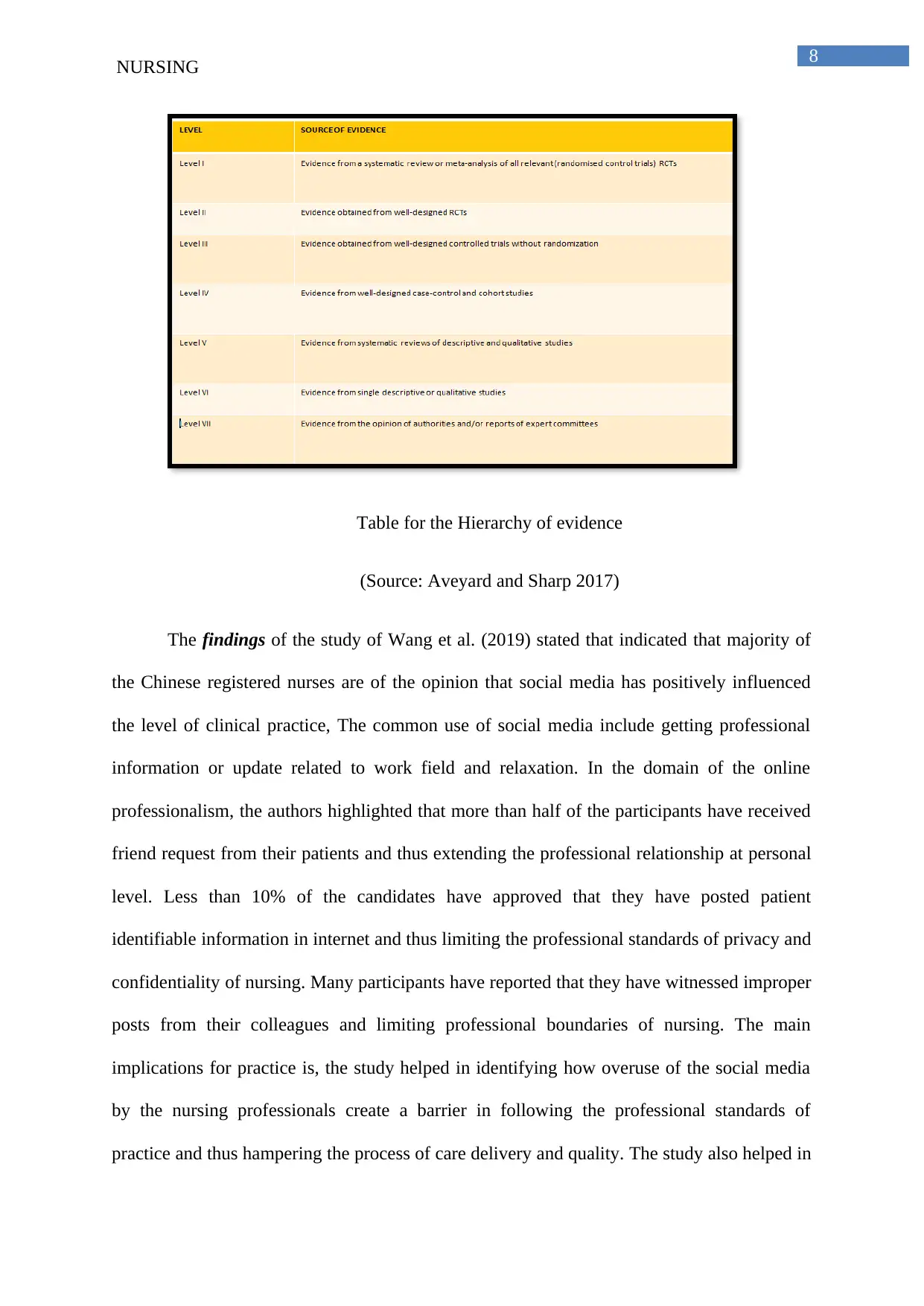
8
NURSING
Table for the Hierarchy of evidence
(Source: Aveyard and Sharp 2017)
The findings of the study of Wang et al. (2019) stated that indicated that majority of
the Chinese registered nurses are of the opinion that social media has positively influenced
the level of clinical practice, The common use of social media include getting professional
information or update related to work field and relaxation. In the domain of the online
professionalism, the authors highlighted that more than half of the participants have received
friend request from their patients and thus extending the professional relationship at personal
level. Less than 10% of the candidates have approved that they have posted patient
identifiable information in internet and thus limiting the professional standards of privacy and
confidentiality of nursing. Many participants have reported that they have witnessed improper
posts from their colleagues and limiting professional boundaries of nursing. The main
implications for practice is, the study helped in identifying how overuse of the social media
by the nursing professionals create a barrier in following the professional standards of
practice and thus hampering the process of care delivery and quality. The study also helped in
NURSING
Table for the Hierarchy of evidence
(Source: Aveyard and Sharp 2017)
The findings of the study of Wang et al. (2019) stated that indicated that majority of
the Chinese registered nurses are of the opinion that social media has positively influenced
the level of clinical practice, The common use of social media include getting professional
information or update related to work field and relaxation. In the domain of the online
professionalism, the authors highlighted that more than half of the participants have received
friend request from their patients and thus extending the professional relationship at personal
level. Less than 10% of the candidates have approved that they have posted patient
identifiable information in internet and thus limiting the professional standards of privacy and
confidentiality of nursing. Many participants have reported that they have witnessed improper
posts from their colleagues and limiting professional boundaries of nursing. The main
implications for practice is, the study helped in identifying how overuse of the social media
by the nursing professionals create a barrier in following the professional standards of
practice and thus hampering the process of care delivery and quality. The study also helped in
⊘ This is a preview!⊘
Do you want full access?
Subscribe today to unlock all pages.

Trusted by 1+ million students worldwide
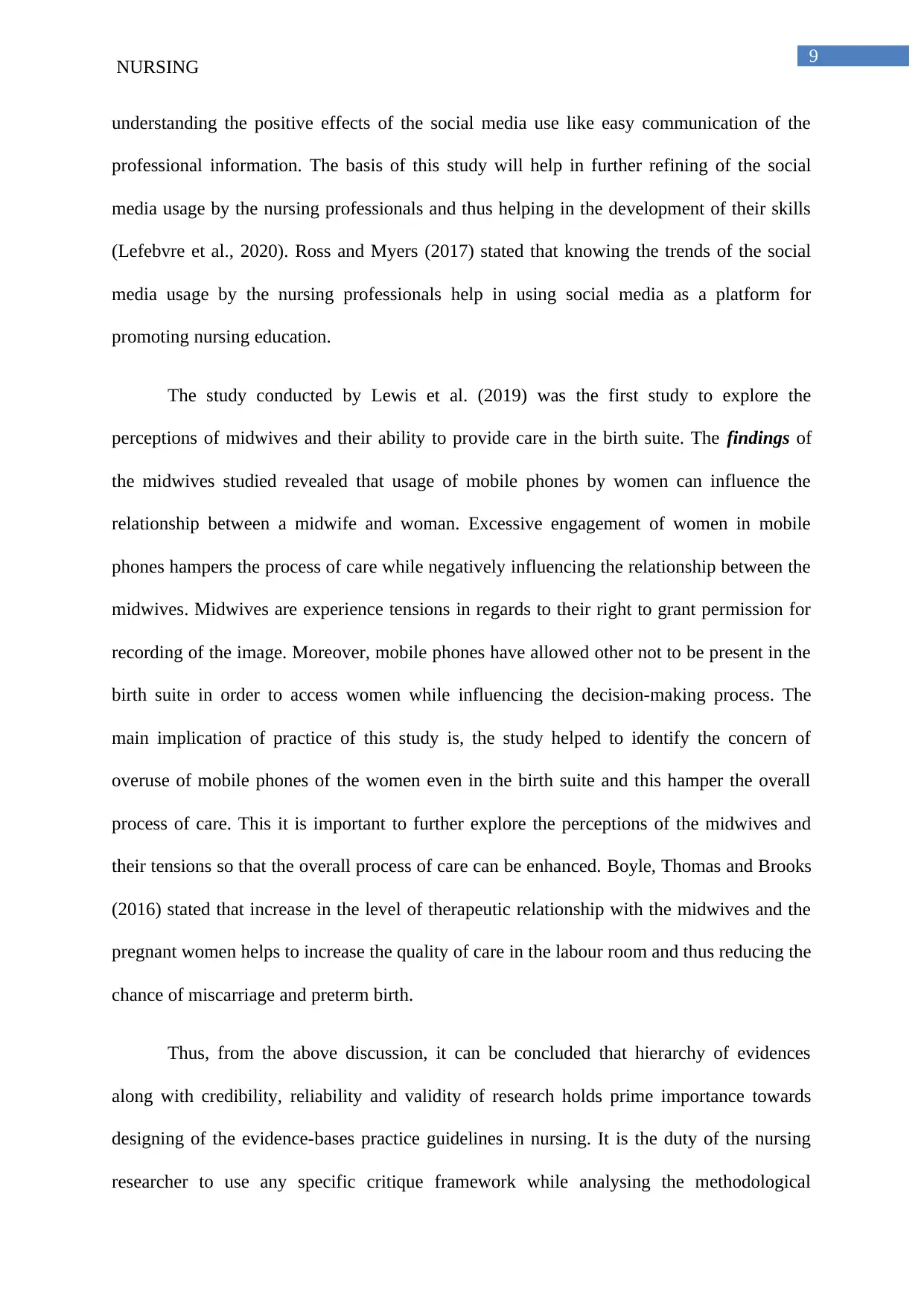
9
NURSING
understanding the positive effects of the social media use like easy communication of the
professional information. The basis of this study will help in further refining of the social
media usage by the nursing professionals and thus helping in the development of their skills
(Lefebvre et al., 2020). Ross and Myers (2017) stated that knowing the trends of the social
media usage by the nursing professionals help in using social media as a platform for
promoting nursing education.
The study conducted by Lewis et al. (2019) was the first study to explore the
perceptions of midwives and their ability to provide care in the birth suite. The findings of
the midwives studied revealed that usage of mobile phones by women can influence the
relationship between a midwife and woman. Excessive engagement of women in mobile
phones hampers the process of care while negatively influencing the relationship between the
midwives. Midwives are experience tensions in regards to their right to grant permission for
recording of the image. Moreover, mobile phones have allowed other not to be present in the
birth suite in order to access women while influencing the decision-making process. The
main implication of practice of this study is, the study helped to identify the concern of
overuse of mobile phones of the women even in the birth suite and this hamper the overall
process of care. This it is important to further explore the perceptions of the midwives and
their tensions so that the overall process of care can be enhanced. Boyle, Thomas and Brooks
(2016) stated that increase in the level of therapeutic relationship with the midwives and the
pregnant women helps to increase the quality of care in the labour room and thus reducing the
chance of miscarriage and preterm birth.
Thus, from the above discussion, it can be concluded that hierarchy of evidences
along with credibility, reliability and validity of research holds prime importance towards
designing of the evidence-bases practice guidelines in nursing. It is the duty of the nursing
researcher to use any specific critique framework while analysing the methodological
NURSING
understanding the positive effects of the social media use like easy communication of the
professional information. The basis of this study will help in further refining of the social
media usage by the nursing professionals and thus helping in the development of their skills
(Lefebvre et al., 2020). Ross and Myers (2017) stated that knowing the trends of the social
media usage by the nursing professionals help in using social media as a platform for
promoting nursing education.
The study conducted by Lewis et al. (2019) was the first study to explore the
perceptions of midwives and their ability to provide care in the birth suite. The findings of
the midwives studied revealed that usage of mobile phones by women can influence the
relationship between a midwife and woman. Excessive engagement of women in mobile
phones hampers the process of care while negatively influencing the relationship between the
midwives. Midwives are experience tensions in regards to their right to grant permission for
recording of the image. Moreover, mobile phones have allowed other not to be present in the
birth suite in order to access women while influencing the decision-making process. The
main implication of practice of this study is, the study helped to identify the concern of
overuse of mobile phones of the women even in the birth suite and this hamper the overall
process of care. This it is important to further explore the perceptions of the midwives and
their tensions so that the overall process of care can be enhanced. Boyle, Thomas and Brooks
(2016) stated that increase in the level of therapeutic relationship with the midwives and the
pregnant women helps to increase the quality of care in the labour room and thus reducing the
chance of miscarriage and preterm birth.
Thus, from the above discussion, it can be concluded that hierarchy of evidences
along with credibility, reliability and validity of research holds prime importance towards
designing of the evidence-bases practice guidelines in nursing. It is the duty of the nursing
researcher to use any specific critique framework while analysing the methodological
Paraphrase This Document
Need a fresh take? Get an instant paraphrase of this document with our AI Paraphraser
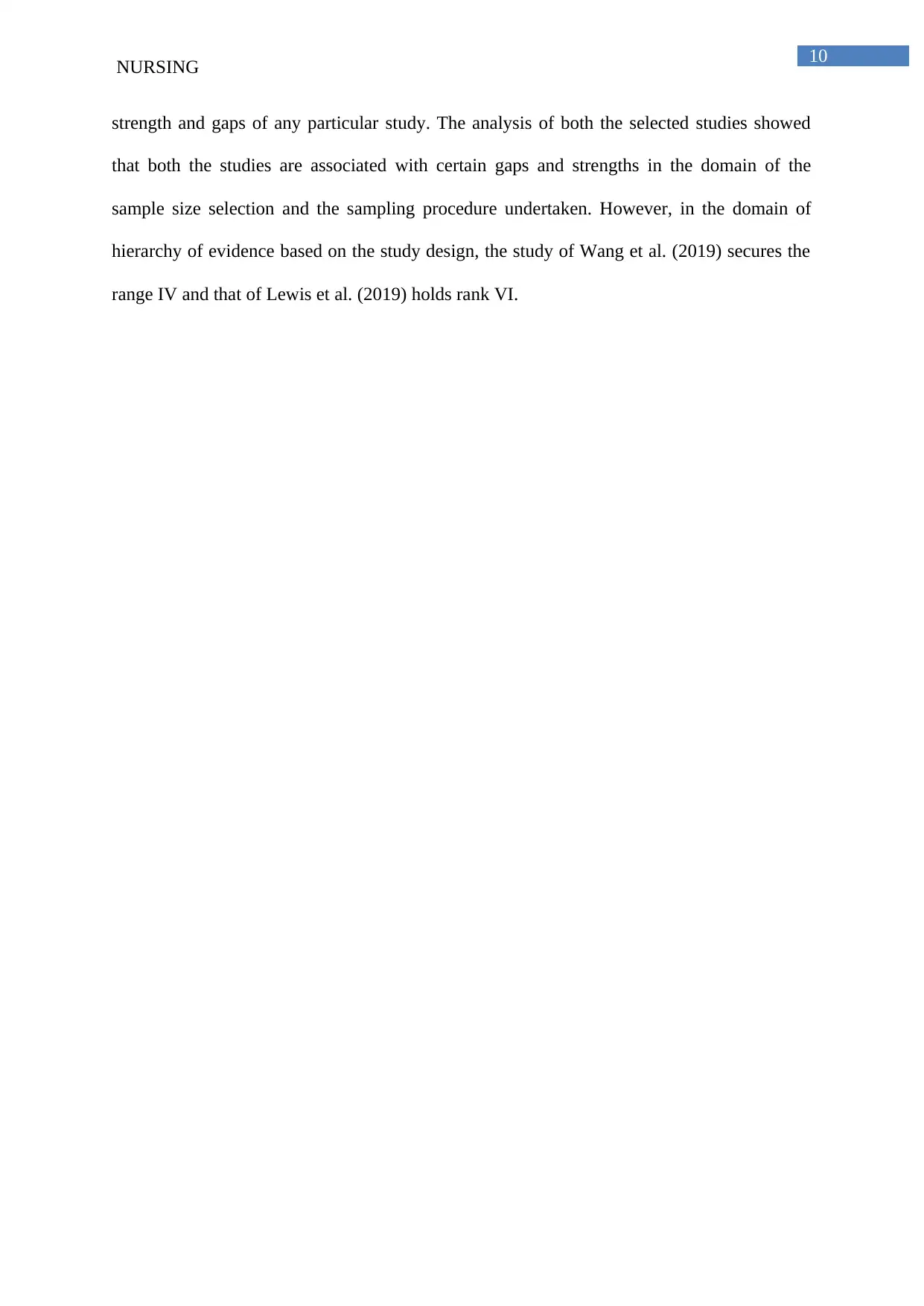
10
NURSING
strength and gaps of any particular study. The analysis of both the selected studies showed
that both the studies are associated with certain gaps and strengths in the domain of the
sample size selection and the sampling procedure undertaken. However, in the domain of
hierarchy of evidence based on the study design, the study of Wang et al. (2019) secures the
range IV and that of Lewis et al. (2019) holds rank VI.
NURSING
strength and gaps of any particular study. The analysis of both the selected studies showed
that both the studies are associated with certain gaps and strengths in the domain of the
sample size selection and the sampling procedure undertaken. However, in the domain of
hierarchy of evidence based on the study design, the study of Wang et al. (2019) secures the
range IV and that of Lewis et al. (2019) holds rank VI.
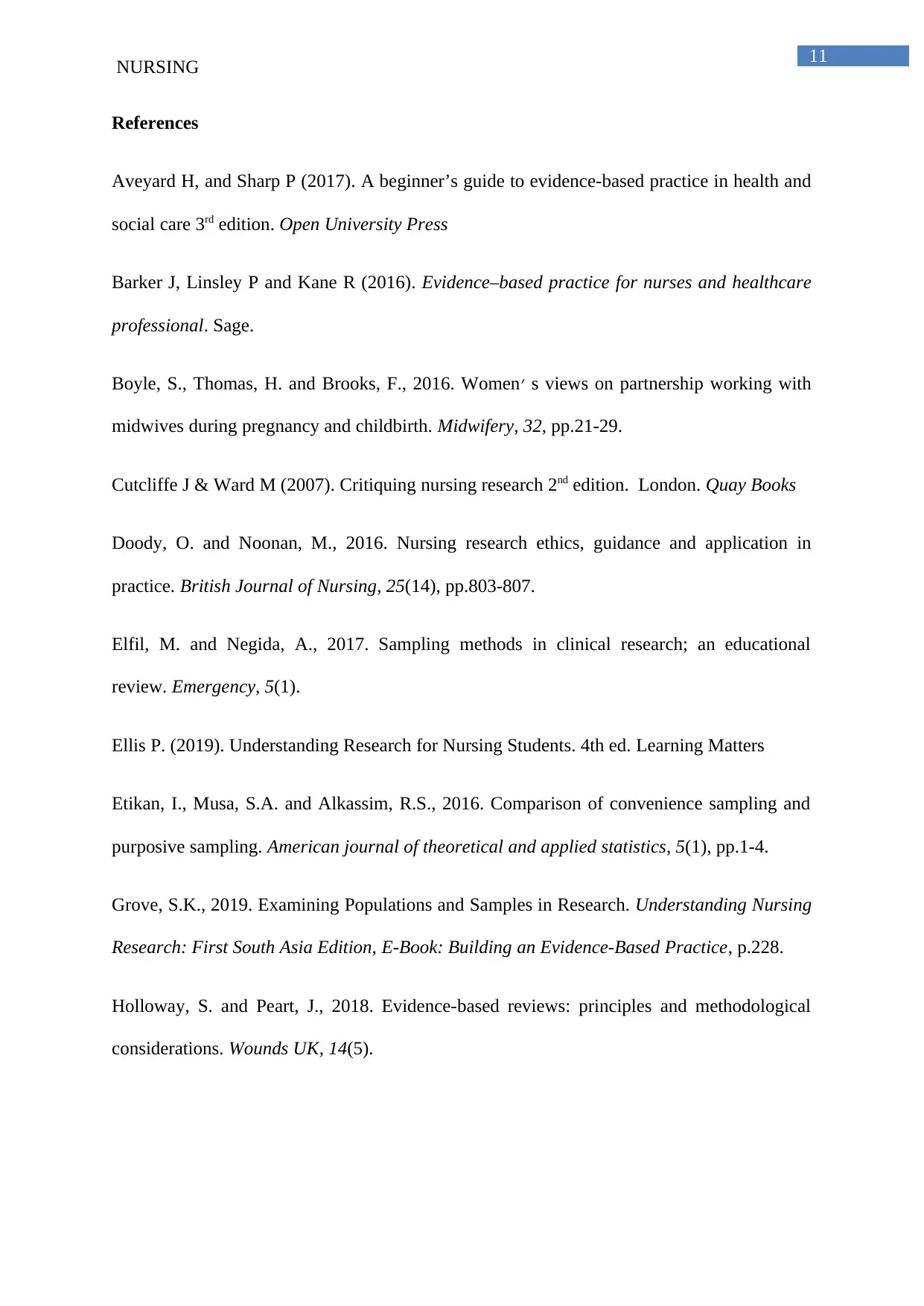
11
NURSING
References
Aveyard H, and Sharp P (2017). A beginner’s guide to evidence-based practice in health and
social care 3rd edition. Open University Press
Barker J, Linsley P and Kane R (2016). Evidence–based practice for nurses and healthcare
professional. Sage.
Boyle, S., Thomas, H. and Brooks, F., 2016. Women׳ s views on partnership working with
midwives during pregnancy and childbirth. Midwifery, 32, pp.21-29.
Cutcliffe J & Ward M (2007). Critiquing nursing research 2nd edition. London. Quay Books
Doody, O. and Noonan, M., 2016. Nursing research ethics, guidance and application in
practice. British Journal of Nursing, 25(14), pp.803-807.
Elfil, M. and Negida, A., 2017. Sampling methods in clinical research; an educational
review. Emergency, 5(1).
Ellis P. (2019). Understanding Research for Nursing Students. 4th ed. Learning Matters
Etikan, I., Musa, S.A. and Alkassim, R.S., 2016. Comparison of convenience sampling and
purposive sampling. American journal of theoretical and applied statistics, 5(1), pp.1-4.
Grove, S.K., 2019. Examining Populations and Samples in Research. Understanding Nursing
Research: First South Asia Edition, E-Book: Building an Evidence-Based Practice, p.228.
Holloway, S. and Peart, J., 2018. Evidence-based reviews: principles and methodological
considerations. Wounds UK, 14(5).
NURSING
References
Aveyard H, and Sharp P (2017). A beginner’s guide to evidence-based practice in health and
social care 3rd edition. Open University Press
Barker J, Linsley P and Kane R (2016). Evidence–based practice for nurses and healthcare
professional. Sage.
Boyle, S., Thomas, H. and Brooks, F., 2016. Women׳ s views on partnership working with
midwives during pregnancy and childbirth. Midwifery, 32, pp.21-29.
Cutcliffe J & Ward M (2007). Critiquing nursing research 2nd edition. London. Quay Books
Doody, O. and Noonan, M., 2016. Nursing research ethics, guidance and application in
practice. British Journal of Nursing, 25(14), pp.803-807.
Elfil, M. and Negida, A., 2017. Sampling methods in clinical research; an educational
review. Emergency, 5(1).
Ellis P. (2019). Understanding Research for Nursing Students. 4th ed. Learning Matters
Etikan, I., Musa, S.A. and Alkassim, R.S., 2016. Comparison of convenience sampling and
purposive sampling. American journal of theoretical and applied statistics, 5(1), pp.1-4.
Grove, S.K., 2019. Examining Populations and Samples in Research. Understanding Nursing
Research: First South Asia Edition, E-Book: Building an Evidence-Based Practice, p.228.
Holloway, S. and Peart, J., 2018. Evidence-based reviews: principles and methodological
considerations. Wounds UK, 14(5).
⊘ This is a preview!⊘
Do you want full access?
Subscribe today to unlock all pages.

Trusted by 1+ million students worldwide
1 out of 14
Related Documents
Your All-in-One AI-Powered Toolkit for Academic Success.
+13062052269
info@desklib.com
Available 24*7 on WhatsApp / Email
![[object Object]](/_next/static/media/star-bottom.7253800d.svg)
Unlock your academic potential
Copyright © 2020–2025 A2Z Services. All Rights Reserved. Developed and managed by ZUCOL.





